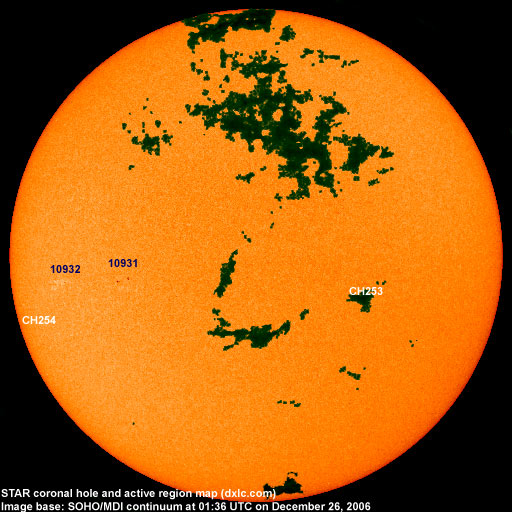

Last major update issued on December 26, 2006 at 06:10 UTC.
[Solar and
geomagnetic data - last month (updated daily)]
[Solar wind and
electron fluence charts (updated daily)]
[Solar cycles 21-23
(last update November 12, 2006)]
[Solar cycles 1-20]
[Graphical comparison
of cycles 21, 22 and 23 (last update November 12, 2006)]
[Graphical
comparison of cycles 2, 10, 13, 17, 20 and 23 (last update November 12,
2006)]
[Historical solar and
geomagnetic data charts 1954-2005 (last update March 3, 2006)]
[Archived reports
(last update December 18, 2006)]
The geomagnetic field was quiet to unsettled on December 25. Solar wind speed ranged between 485 and 593 km/s (all day average 553 km/s - decreasing 48 km/s from the previous day).
Solar flux measured at 20h UTC on 2.8 GHz was 76.4. The planetary A index was 6 (STAR Ap - based on the mean of three hour interval ap indices: 5.9). Three hour interval K indices: 32212101 (planetary), 32212212 (Boulder).
The background x-ray flux is far below the class A1 level.
At midnight there were 2 spotted regions on the visible solar disk. The solar flare activity level was very low. No C class events were recorded during the day.
New region 10931 emerged in the southeast quadrant on December 25.
New region 10932 emerged in the southeast quadrant on December 24 and was
numbered the next day by SEC.
December 23-25: No obvious partly or fully Earth directed CMEs were detected in LASCO imagery. During the evening of December 24 a wide (at least partial halo) CME was observed over most of the southern hemipshere limbs and the south pole. The source of this CME was probably backsided.
Coronal hole
history (since late October 2002)
Compare today's report to the situation one solar rotation ago:
28
days ago
27
days ago
26
days ago
A small coronal hole (CH253) in the southern hemisphere was in an Earth facing position on December 24. A large recurrent coronal hole (CH254) in the southern hemisphere

Processed SOHO/EIT 195 image at 00:48 UTC on December 26. The darkest areas on the solar disk are likely coronal holes.
The geomagnetic field is expected to be mostly quiet on December 26-31. A few unsettled and active intervals are possible on December 27 due to effects from CH253.
| Coronal holes (1) | Coronal mass ejections (2) | M and X class flares (3) |
1) Effects from a coronal hole could reach Earth
within the next 5 days. When the high speed stream has arrived the
color changes to green.
2) Effects from a CME are likely to be observed at Earth within 96
hours.
3) There is a possibility of either M or X class flares within the next
48 hours.
Green: 0-20% probability, Yellow: 20-60% probability, Red: 60-100% probability.
Long distance low and medium frequency (below 2 MHz) propagation along east-west paths over high and upper middle latitudes is poor and improving. Propagation on long distance northeast-southwest paths is very poor.
Monitoring remarks from a location near N58E06: Several stations from the east coast of North America, from Puerto Rico and Venezuela were noted during the night. The best signal was noted from 1660 WCNZ.

Compare to the previous day's image.
Data for all numbered solar regions according to the Solar Region Summary provided by NOAA/SEC. Comments are my own, as is the STAR spot count (spots observed at or inside a few hours before midnight) and data for regions not numbered by SEC or where SEC has observed no spots. SEC active region numbers in the table below and in the active region map above are the historic SEC/USAF numbers.
| Active region | Date numbered | SEC spot count |
STAR spot count |
Location at midnight | Area | Classification | Comment |
|---|---|---|---|---|---|---|---|
| 10931 | 2006.12.25 | 10 | 6 | S07E35 | 0020 | CSO | classification was DSO at midnight |
| 10932 | 2006.12.25 | 1 | 1 | S08E55 | 0010 | AXX | formerly region S685 |
| Total spot count: | 11 | 7 | |||||
| SSN: | 31 | 27 | |||||
| Month | Average solar flux at Earth |
International sunspot number | Smoothed sunspot number |
|---|---|---|---|
| 2000.04 | 184.2 | 125.5 | 120.8 cycle 23 sunspot max. |
| 2000.07 | 202.3 | 170.1 | 119.8 |
| 2001.12 | 235.1 | 132.2 | 114.6 (-0.9) |
| 2005.09 | 91.1 | 21.9 | 25.8 (-1.6) |
| 2005.10 | 77.0 | 8.7 | 25.5 (-0.3) |
| 2005.11 | 86.3 | 18.0 | 24.9 (-0.6) |
| 2005.12 | 90.7 | 41.1 | 23.0 (-1.9) |
| 2006.01 | 83.4 | 15.3 | 20.8 (-2.2) |
| 2006.02 | 76.5 | 4.9 | 18.6 (-2.2) |
| 2006.03 | 75.4 | 10.6 | 17.3 (-1.3) |
| 2006.04 | 89.0 | 30.2 | 17.1 (-0.2) |
| 2006.05 | 80.9 | 22.2 | 17.3 (+0.2) |
| 2006.06 | 76.5 | 13.9 | (16.3 predicted, -1.0) |
| 2006.07 | 75.7 | 12.2 | (14.7 predicted, -1.6) |
| 2006.08 | 79.0 | 12.9 | (14.2 predicted, -0.5) |
| 2006.09 | 77.8 | 14.5 | (14.1 predicted, -0.1) |
| 2006.10 | 74.3 | 10.4 | (13.0 predicted, -1.1) |
| 2006.11 | 86.3 | 21.5 | (11.5 predicted, -1.5) |
| 2006.12 | 86.1 (1) | 19.4 (2) | (11.3 predicted, -0.2) |
1) Running average based on the
daily 20:00 UTC observed solar flux
value at 2800 MHz.
2) Unofficial, accumulated value based on the Boulder (NOAA/SEC)
sunspot number. The official international sunspot number is typically
30-50% lower.
This report has been prepared by Jan Alvestad. It is based partly on my own observations and analysis, and partly on data from some of these solar data sources. All time references are to the UTC day. Comments and suggestions are always welcome.
| [DX-Listeners' Club] |